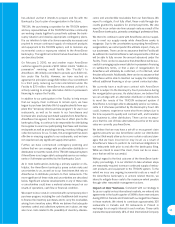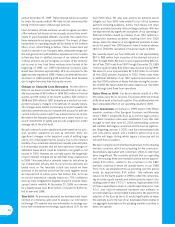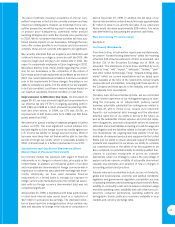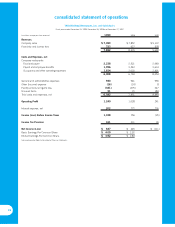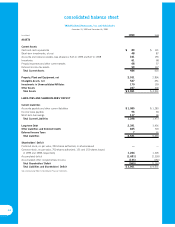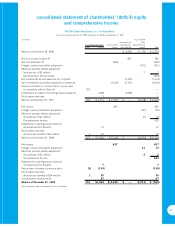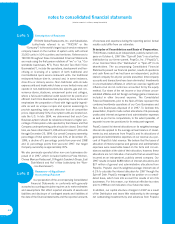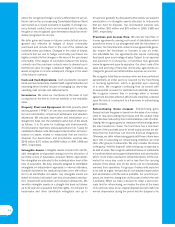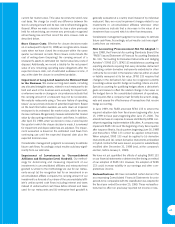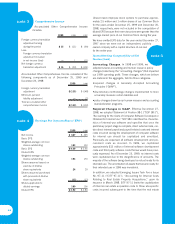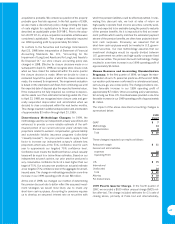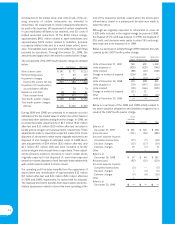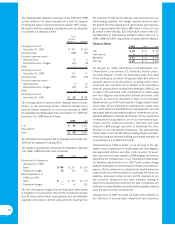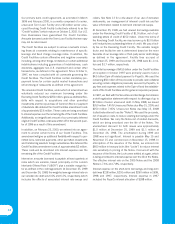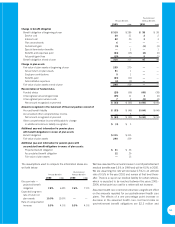Pizza Hut 1999 Annual Report Download - page 47
Download and view the complete annual report
Please find page 47 of the 1999 Pizza Hut annual report below. You can navigate through the pages in the report by either clicking on the pages listed below, or by using the keyword search tool below to find specific information within the annual report.
45
current fair market value. This value becomes the store’s new
cost basis. We charge (or credit) any difference between the
store’s carrying amount and its new cost to refranchising gains
(losses). When we make a decision to close a store previously
held for refranchising, we reverse any previously recognized
refranchising loss and then record the store closure costs as
described below.
Store Closure Costs. Effective for closure decisions made
on or subsequent to April 23, 1998, we recognize store closure
costs when we have closed the restaurant within the same
quarter our decision is made. Store closure costs include the
cost of writing-down (impairing) the carrying amount of a
restaurant’s assets to estimated fair market value less costs of
disposal. Additionally, we record a liability for the net present
value of any remaining operating lease obligations after the
expected closure date, net of estimated sublease income, if
any, at the date the closure is considered probable.
Impairment of Long-Lived Assets to be Held and Used
in the Business. We review our long-lived assets, including
any allocated intangible assets, related to each restaurant to be
held and used in the business semi-annually for impairment,
or whenever events or changes in circumstances indicate that
the carrying amount of a restaurant may not be recoverable.
We evaluate restaurants using a “two-year history of operating
losses” as our primary indicator of potential impairment. Based
on the best information available, we write down an impaired
restaurant to its estimated fair market value, which becomes
its new cost basis. We generally measure estimated fair market
value by discounting estimated future cash flows. In addition,
after April 23, 1998, when we decide to close a store beyond
the quarter in which the closure decision is made, it is reviewed
for impairment and depreciable lives are adjusted. The impair-
ment evaluation is based on the estimated cash flows from
continuing use until the expected disposal date plus the
expected terminal value.
Considerable management judgment is necessary to estimate
future cash flows. Accordingly, actual results could vary signif-
icantly from our estimates.
Impairment of Investments in Unconsolidated
Affiliates and Enterprise-Level Goodwill. Our method-
ology for determining and measuring impairment of our
investments in unconsolidated affiliates and enterprise-level
goodwill is similar to the methodology we use for our restau-
rants except (a) the recognition test for an investment in an
unconsolidated affiliate compares the carrying amount of our
investment to a forecast of our share of the unconsolidated affil-
iate’s undiscounted cash flows including interest and taxes
instead of undiscounted cash flows before interest and taxes
used for our restaurants and (b) enterprise-level goodwill is
generally evaluated at a country level instead of by individual
restaurant. Also, we record impairment charges related to our
investments in unconsolidated affiliates whenever other
circumstances indicate that a decrease in the value of an
investment has occurred which is other than temporary.
Considerable management judgment is necessary to estimate
future cash flows. Accordingly, actual results could vary signif-
icantly from our estimates.
New Accounting Pronouncement Not Yet Adopted. In
June 1998, the Financial Accounting Standards Board (the
“FASB”) issued Statement of Financial Accounting Standards
No. 133, “Accounting for Derivative Instruments and Hedging
Activities” (“SFAS 133”). SFAS 133 establishes accounting and
reporting standards requiring that every derivative instrument
(including certain derivative instruments embedded in other
contracts) be recorded in the balance sheet as either an asset
or liability measured at its fair value. SFAS 133 requires that
changes in the derivative’s fair value be recognized currently
in earnings unless specific hedge accounting criteria are met.
Special accounting for qualifying hedges allows a derivative’s
gains and losses to offset the related change in fair value on
the hedged item in the consolidated statement of operations,
and requires that a company must formally document, desig-
nate and assess the effectiveness of transactions that receive
hedge accounting.
In June 1999, the FASB amended SFAS 133 to extend the
required adoption date from fiscal years beginning after June
15, 1999 to fiscal years beginning after June 15, 2000. The
amendment was in response to issues identified by FASB con-
stituents regarding implementation difficulties. A company may
implement SFAS 133 as of the beginning of any fiscal quarter
after issuance (that is, fiscal quarters beginning June 16, 1998
and thereafter). SFAS 133 cannot be applied retroactively.
When adopted, SFAS 133 must be applied to (a) derivative
instruments and (b) certain derivative instruments embedded
in hybrid contracts that were issued, acquired or substantively
modified after December 31, 1998 (and, at the company’s
election, before January 1, 1999).
We have not yet quantified the effects of adopting SFAS 133
on our financial statements or determined the timing or method
of our adoption of SFAS 133. However, the adoption of SFAS
133 could increase volatility in our earnings and other com-
prehensive income.
Reclassifications. We have reclassified certain items in the
accompanying Consolidated Financial Statements for prior
periods to be comparable with the classification we adopted for
the fiscal year ended December 25, 1999. These reclassifica-
tions had no effect on previously reported net income or loss.


